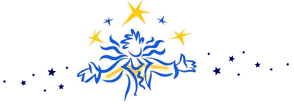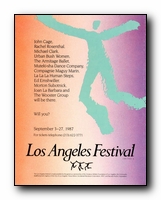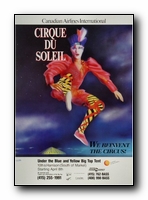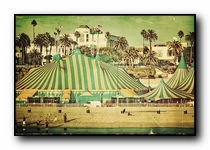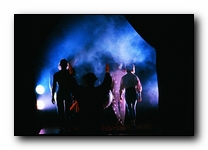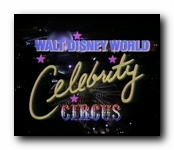

![]()
1980s
1982 · 19831984 · 1985
1986 · 1987
1988 · 1989
1990s
1990 · 19911992 · 1993
1994 · 1995
1996 · 1997
1998 · 1999
2000s
2000 · 20012002 · 2003
2004 · 2005
2006 · 2007
2008 · 2009
2010s
2010 · 20112012 · 2013
2014 · 2015
2016 · 2017
2018 · 2019
2020s
2020 · 20212022 · 2023
2024

A METEORIC RISE
MAKE OR BREAK IN LOS ANGELES
In the documentary film "Run Before You Fly", Schumacher remembers: "I get a lot of credit for saying I saw Cirque du Soleil and told them to come to the Los Angeles Festival. It actually happened through a man at the Quebec Delegation called Michel Robitaille. I went to have lunch with him one day to say, 'I want money to bring Montreal dancer and choreographer Édouard Lock to LA, to the Festival.' I needed $50,000 to cover travel or something. And he said, 'We'll give you funding to bring Édouard Lock and La La La Human Steps, but I want you to go see a circus.' I laughed at him and said, 'We're not going to bring a circus to the LA Festival. It's an arts festival!'" Seeing Cirque du Soleil on videotable changed Schumacher's mind. "It was a Wednesday," he recalls. "I went back to Robitaille's office, I watched a videotape. I was blown away, and Friday night I was in Quebec City. Guy Laliberté picked me up at the airport and drive me to the site. I saw the second half of the show that night. I saw it twice Saturday, twice on Sunday, and we made the decision Sunday night." Though Schumacher wanted Cirque du Soleil for his festival, he couldn't afford to pay them, foot the bill for transporting hundreds of tons of equipment, or even house the over 80 people in the troupe. "Festival officials thought that the event was too risky for their young operation," Jean David, Cirque du Soleil's marketing and communications vice-president wrote in his book Quel Cirque. "If our show failed, the consequences would have a disastrous impact on their operating budget and their reputation in the American entertainment industry." Despite this, Laliberté says the opportunity was too good to pass up: "I thought, 'I'm not going to wait twenty years to see if we can make a living off what we do. The opportunity is here, let's make a deal. I told Thomas Schumacher, 'Give us the opening slot, promotion, and one hundred percent of the gate.'" So they struck a deal: the festival didn't produce the show; it assumed no financial risk. It also meant the Festival didn't share in the bounty should the show take off.
The company was playing for its future in front of a star-spangled audience of show-business moguls and the world's most jaded entertainment media; they swung into action that opening night on a wing and a prayer... THE GAMBLE PAYS OFF According to Jean David, the announcement of the agreement between Cirque du Soleil and the Festival got a cold reception in Hollywood. Many media outlets and critics from the arts world castigated the organizers for opening the festival with a 'circus.' What was a circus doing in such a major event? Criticism was heaped on the festival. "Rumor had it on opening night that the cultural elite would be lying in wait for us under the big top in the industrial quarter of Little Tokyo. The outlook was decidedly grim. The media had no idea who we were. But they would soon find out." Another issue brewing was an internal one - where was Guy Laliberté? Laliberté, a consummate networker, worked hard to make sure the show was a success. While colleagues slaved to put up the tent, Laliberté, the story goes, was nowhere to be found. Mutiny was on the minds of many. But that all changed on opening night. In the days and nights-especially the nights-leading up to the opening, their absentee leader had been out talking up his show with the beautiful people in L.A.'s restaurants and nightclubs. He succeeded in generating the buzz that made the virtually unknown Cirque the must-see act of the 1987 Los Angeles Festival. The night after Le Cirque Réinventé opened, the response by the press and the public provoked a media frenzy. The critics that had been looking forward to lambasting the Cirque were so enchanted by what they saw they considered the show the only one in the festival worth seeing. "A complete reversal of the situation," David noted. "There was widespread astonishment." The next night there was a three-block lineup snaked outside the box office. Cirque du Soleil sold out in less than a week. The company even had to erect a fence and setup valet parking for all the celebrities coming to see the show again and again! A TOTAL SUCCESS!
The circus had indeed arrived. While Cirque du Soleil became an overnight success -- "Within hours of the first press reviews, dozens of producers, managers, agents and sales persons of all sorts showed up. Americans, Israelis, Germans, Japanese, Arabs — they all wanted to see us to negotiate, talk, buy the company, rent our services, produce us, represent us, film us, finance us, assist us, advise us... it was almost overwhelming." -- they also catch some unwanted attention. Executives from Columbia Pictures become enthralled with the show and meet with Laliberté and Gauthier under the pretense of wanting to make a movie about Cirque du Soleil and its success. Laliberté was unhappy with the deal, claiming it gave Columbia too many rights, in attempting to secure all rights to the production. Laliberté and Gauthier pulled out before it could be concluded, keeping Cirque du Soleil independent. (Consequently, Guy Laliberté has expressed that experience stands out as a key reason why Cirque remained independent and privately owned for 30 years.) It's rapid development in three years has amazed almost everybody except Laliberté. "Growth was one of my targets," he says calmly. "I didn't know exactly how we would do it, but I always knew it was possible. And who knows, maybe Le Cirque du Soleil will only be the seed of something else?" 
 |


![[Back]](../images/arrow.gif)

